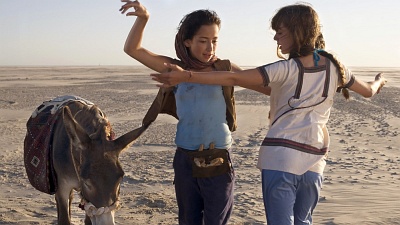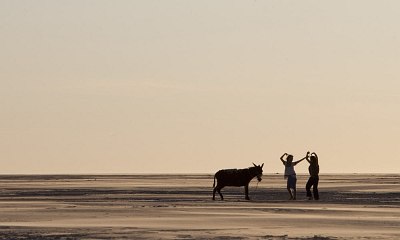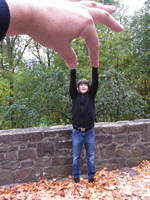Donkey Girl
Film info
Title: Donkey Girl
Running time: 13 min.
Director: Ties Schenk
Country of origin: The Netherlands, 2006
Genre: Live action fiction
Language: Dutch, Arabic
Suggested age group: 11-14 years
Synopsis
Farouzi (12), a Dutch-Arabic girl, is daydreaming while she is looking outside during her work at a fishery. She doesn't care about the boys in the fishery, the only thing that really means something to her is her donkey Soufiane, who always follows her.
One day a girl comes by the fishery on a scooter. The arrival of this self-willed girl makes Farouzi decide to jump on her donkey, and leave to find happiness. The two girls encounter each other at the beach. Somehow they understand each other. Little by little they become closer to each other. The mysterious encounter of the two girls is portrayed with gentle yet powerful images.
Main themes
Stereotypes
Personal happiness
Peer relations
Uncertainty
Feeling different
Following instinct
Cultural diversity
Activities
| A. Before | the film: | Introduction | 5 min. | |
| Exercise 1 | Boys and girls things! | pairs | 30 min. | |
| B. Showing the film: | 15 min. | |||
| C. After the film: | ||||
| Exercise 2 | First impressions | together | 15 min. | |
| Exercise 3 | Where, when and who? | together | 15 min. | |
| Exercise 4 | Don’t say it! | individual | 15 min. | |
A: Before the film
Introduction
Before showing the film it is recommended you make clear to your pupils what it portrays: that the main characters are two girls, who feel attracted to one another, kiss each other and perhaps fall in love.
Have a discussion with your pupils about:
Have you ever be in love?
Do you know people who are in love?
What does that mean?
What do you or do they feel?
Can you see if someone is in love?
What happens when one’s falling in love?
Is it always nice to be in love?
Is it possible to fall in love with people of the same sex?
Is it possible to fall in love with people of different religion?
Is it possible to fall in love with people of very different age? Is it possible to fall in love with people in different countries?
Is it possible to fall in love with people of different ethnic background?
What are your dreams about your future?
What do you expect from friendships and relationships?
Exercise 1: Boys and girls things! (stereotypes)
To make pupils aware of stereotypes of boys’ and girls’ things, you can have them collect images from the internet and discuss their choice.
If you prefer, students can collect items thematically: for example on fashion, professions, leisure, sport, TV programmes, etc. Have them discuss each image in pairs using the questions in the box.
Be careful about pupils who enjoy embarrassing others with their choices, and potential pornographic images available on the internet.
Why did you choose this?
Why is this a typical boys’ or a girls’ thing?
What makes this is a typical boys’ or typical girls’ thing?
What do you like yourself?
How you feel if you like a non-boy thing as a boy? How you feel if you like a non-girl thing as a girl?
How you feel if you like a girl thing as a boy?
How you feel if you like a boy thing as a girl?
Make an image of yourself with the things you like.
C: After the film
Exercise 2: First impressions
To gauge the pupils’ first impressions you might use four headings:
THE FILM MAKES ME…
KEY MOMENTS
VISUAL ASPECTS
QUESTIONS
Give the students some time to write down their findings on the blackboard or flipcharts. You may need to explain the keywords briefly.
THE FILM MAKES ME
Under this first heading they list the emotions they felt whilst watching the film. These can be content related, but also feelings of approval or disapproval.
KEY MOMENTS
Under the second heading they list any moments out of the film that appealed to them; moments they remember; moments that touched them.
VISUAL ASPECTS
The third heading is used to note down all technical aspects they noticed during the viewing; things about the camerawork, sound, music, colour, lighting, acting and so forth.
QUESTIONS
Under the item ‘questions’ the pupils can formulate all kinds of questions about things they didn’t understand including content, characters, setting, dialogue, storyline…
After this exercise you have a picture of what are the live issues for the group: the key scenes, some important visual aspects and posed questions, any of which may provide good starting point for further discussion.
Exercise 3: Where, when and who? (following instinct)
The time and the place of the film are very indeterminate and dreamlike.
We hear several languages (Arabic, Dutch, French and subtitled in English) and see people of different ethnic origin, the girls sing an Arabic song. Their clothing, housing etc, do not provide certainty as to where and when the story develops.
Where and when do you think this all takes place?
It definitely looks like a southern country. Maybe Morocco?
What makes you get this impression?
The title is written in a font that resembles Arabic letters, there’s oriental music in the soundtrack. The boat in the water, the donkey, the fishing nets etc appear foreign to most children.
Surprisingly enough the film was shot at the small island Vlieland, in the north of the Netherlands. Ask the pupils how they think this is possible. Most of the film is shot on the beach. The filmmaker chose a part of the beach where you can only see water and sand. It could be anywhere. No houses, no bins, no ice cream carts, etc that could give away the exact location. Artificial lighting makes it look as if it is very sunny and warm. We only hear the sound of the sea. No cars, trains, factories, etc
They used an old wooden boat on purpose instead of one made of new materials, they put the fishnets on the pier, dressed up the donkey with an oriental fabric and this way ‘fooled’ the viewer!
With your class, explore ways in which images can be used to ‘trick’ viewers.
For example, using a camera and step ladder, change the direction of the camera to make it appear that someone is walking up a wall, flying or standing on one finger. All that is needed is a plain, even background.
Alternatively make use of the fact that objects close to the camera appear larger. The further away you move, the smaller the objects become. You can use this to make a photograph where for example it looks like a student is leaning against a pen (pen close to the camera, student further away). It takes a bit of trial and error to get the right position but the result is guaranteed to amuse!
Exercise 4: Don’t say it! (uncertainty and inner feelings)
The film starts with a short poem:
“Where do the fish pee?
For the time being it’s a guess.
They live above judgment,
Because fish don’t judge.
For a fish there’s no water
And for the water there’s no fish.
The water is the fish.”
At the end there is no dialogue, when the two girls kiss each other. The girls start singing and dancing together instead of talking. Also in this movie, Farouzi doesn’t talk about certain things, like uncertainty and inner feelings. Discuss the fact that sometimes it is hard to talk about subjects, and that this often forms the basis of song lyrics.
Songwriters and poets write instead of speaking. Have all pupils write one sentence of between four and seven words concerning friendship. Ask everyone to read THEIR own phrase aloud, then re- order the phrases to form a poem, or song lyric, or have the students write an individual piece about their inner feelings.






